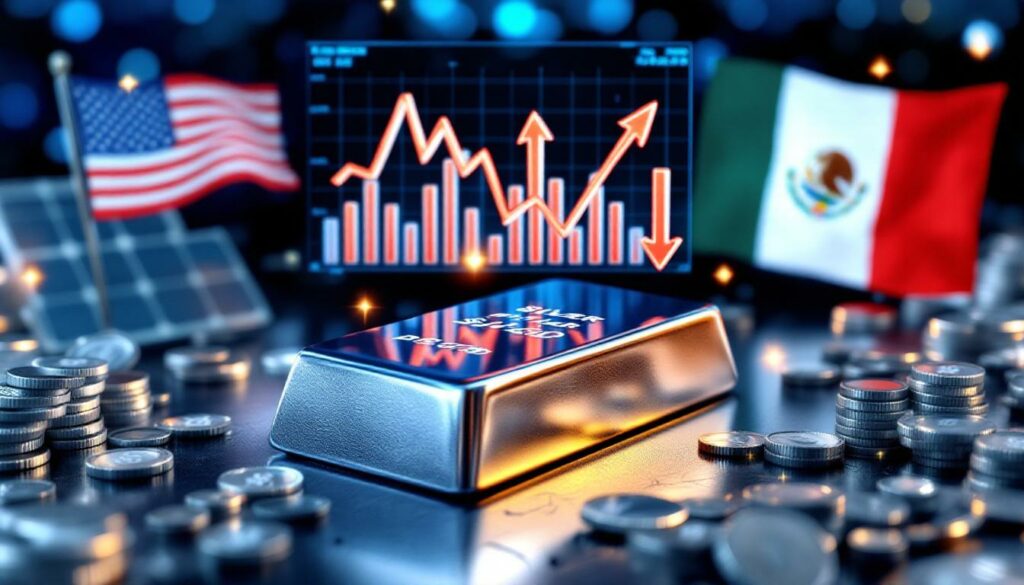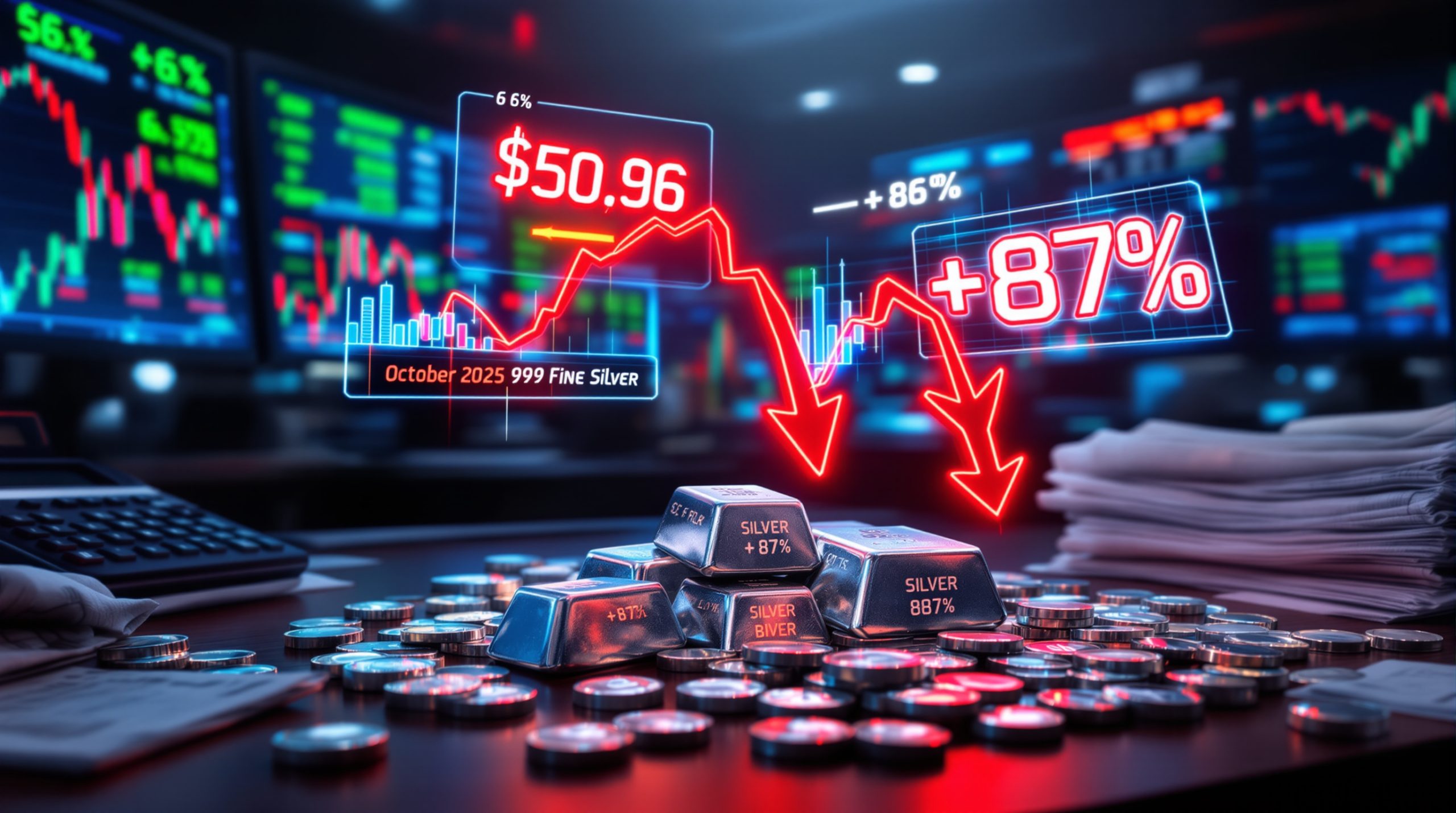Understanding Silver's Recent Price Retreat: Market Dynamics and Future Outlook
What Caused Silver's Recent Price Retreat?
Dollar Strength and Trade Tensions
Silver retreated 0.8% from its nearly 14-year high as the U.S. dollar strengthened significantly during July 2025 trading sessions. The greenback advanced 0.2% during U.S. trading hours on July 14, putting pressure on dollar-denominated commodities like silver.
The primary catalyst behind this dollar strength was President Trump's announcement of new 30% tariffs impact on markets targeting Mexico and the European Union. These tariffs, set for implementation on August 1, 2025, have created considerable market uncertainty.
"Trade tensions directly strengthen the dollar, which inevitably pressures commodities priced in the currency," noted Bloomberg Intelligence analysts in their July 14 market commentary.
Mexico's position as the world's largest silver producer—accounting for approximately 23% of global output with 6,300 metric tons produced in 2024—makes this trade tension particularly significant for silver markets.
Market Impact Alert:
Silver prices dropped to $38.23/oz within hours of the tariff announcement, demonstrating the market's immediate sensitivity to trade policy shifts affecting major producing nations.
Supply-Demand Dynamics Creating Volatility
Beyond geopolitical factors, the physical silver market is experiencing unprecedented tightening. One-month silver borrowing costs have surged to over 6% annualized—a dramatic increase from the typical near-zero rates that have historically prevailed.
This lending rate spike indicates extreme short-term supply shortages in the London physical market, where available inventory has become increasingly scarce. The situation has been exacerbated by substantial buying activity from both industrial users and investment vehicles.
How Has Silver Performed in 2025?
Silver's Impressive Price Rally
Despite the recent pullback, silver has been one of the standout performers in commodity markets during 2025. The metal has gained an impressive 32% year-to-date through July 14, significantly outpacing gold's 27% increase over the same period.
Silver reached above $39 per ounce—its highest level since 2011—before the recent retreat to $38.23/oz. This performance comes as the market heads toward its fifth consecutive annual deficit, according to data from the Silver Institute.
The extended deficit situation reflects structural challenges in meeting growing demand from both industrial applications and investment flows.
Comparative Performance Metrics
Silver's performance becomes even more noteworthy when analyzed in relation to other precious metals:
| Metal | YTD Performance (Jan-Jul 2025) | July 14, 2025 Price Action |
|---|---|---|
| Silver | +32.0% | -0.8% |
| Gold | +27.0% | -0.5% |
| Platinum | +18.4% | -3.68% |
| Palladium | +10.2% | -3.92% |
The gold-silver ratio analysis currently stands at 86:1, down from higher levels earlier in the year but still above the historical 10-year average of 80:1. This ratio indicates silver remains relatively undervalued compared to gold by historical standards.
"Silver's industrial-demand component tends to drive outperformance versus gold during economic growth cycles," according to Metals Focus in their July 2025 market outlook. "This dual-nature as both industrial metal and monetary asset creates unique price dynamics."
Why Is Physical Silver Supply Under Pressure?
ETF Accumulation Impact
A significant portion of London's registered silver holdings are now locked in exchange-traded funds, making this metal unavailable for lending or market purchases. ETF holdings have expanded by approximately 2,570 tons since February 2025 alone.
This ETF accumulation has profound effects on physical market dynamics:
- Reduced liquidity: Physical metal becomes unavailable for industrial users
- Price premiums: Spot market transactions command higher premiums
- Lending market stress: Borrowing costs surge due to limited float
- Backwardation risk: Spot prices exceed futures in tight markets
"ETF vaults effectively lock away physical stock, creating artificial scarcity for industrial users who need the actual metal," explains a recent LBMA market report from July 2025.
London vaults now report that an unprecedented 82% of all registered silver is held by ETFs, according to the most recent LBMA monthly data.
Industrial Demand Factors
Silver's industrial applications continue to expand, particularly in the renewable energy sector. Solar panel manufacturing alone accounts for nearly 15% of global silver demand, with each panel requiring approximately 20 grams of silver.
This industrial demand creates a unique market dynamic where silver retreats from almost 14 year high as dollar pushes higher, while simultaneously facing:
- Growing baseline consumption from traditional industrial uses
- Accelerating demand from green energy applications
- Limited supply elasticity with mine production growing at just 0.8% CAGR since 2020
- Competing investment demand during economic uncertainty
The combination of these factors has contributed to the market deficit continuing for its fifth consecutive year, with limited new supply coming online to meet the growing demand.
How Might Trade Policies Affect Silver Markets?
Mexico-US Trade Implications
Mexico's position as the top silver producer globally creates a particular vulnerability in the supply chain. The country supplies approximately 40% of U.S. silver imports according to the U.S. Geological Survey's 2024 data.
Under the current USMCA agreement, silver is classified as a critical mineral and remains exempt from the latest tariff announcements. However, market participants remain concerned about potential changes to this exemption status.
"Mexican export disruptions could spike physical premiums by 15-20% in North American markets," warns CPM Group in their July 2025 trade analysis.
Important technical details of the USMCA provisions include:
- Preferential treatment for designated critical minerals including silver
- Exemption revocation would require a 90-day notice period
- Cross-border refining operations would face immediate cost pressures
Global Trade Uncertainty
Escalating trade tensions extend beyond the Mexico-U.S. relationship, creating broader market volatility. The strengthening dollar typically pressures commodity trading trends across the board, but precious metals respond to competing forces during such periods:
- Negative factor: Dollar strength makes dollar-denominated metals more expensive for foreign buyers
- Positive factor: Economic uncertainty drives safe-haven demand
- Mixed impact: Industrial demand concerns versus investment flows
- Supply risk: Potential for cross-border supply chain disruptions
Historical precedent from the 2018 tariff implementations shows that physical silver premiums increased by approximately 12% during similar trade tensions, according to LBMA historical data.
What Technical Factors Are Influencing Silver Prices?
Market Positioning and Sentiment
The recent price pullback follows an extended rally period that brought silver to multi-year highs. Technical analysis suggests silver encountered significant resistance at the $39/oz level, which corresponds to important price points from 2011-2012.
Current technical indicators show:
- Consolidation pattern forming after reaching overbought conditions
- Declining volume during the pullback, suggesting limited selling pressure
- Bollinger Band width at a 3-month high, indicating expanded volatility
- Relative strength compared to other precious metals despite correction
"Profit-taking after reaching 14-year highs is perfectly normal market behavior, but continued ETF inflows suggest underlying strength remains intact," notes Technical Analysis Ltd. in their July 2025 metals outlook.
Price Support Levels
Several key support zones have been established during recent price action:
- Primary support: $37.80-$38.20 (June 2025 consolidation zone)
- Secondary support: $36.50 (May 2025 breakout level)
- Major support: $34.75 (200-day moving average)
These technical levels provide potential floor prices where buying interest may emerge. The market pattern resembles the 2020 consolidation at $26 before silver surged to $30, suggesting a similar pattern could develop in the current environment.
What's The Outlook For Silver Through 2025?
Supply-Demand Projections
The ongoing market deficit is expected to continue through 2025 and potentially beyond. The Silver Institute projects a deficit exceeding 4,000 tons for the current year, building upon the 3,100-ton shortfall recorded in 2024.
Key supply-demand factors shaping the outlook include:
- Solar demand growth: Projected at +15% year-over-year according to BloombergNEF
- ETF inflows: Averaging +217 tons monthly since February 2025
- Mine supply inelasticity: Less than 1% production growth despite multi-year price highs
- Limited project pipeline: Only three major new mining projects scheduled before 2027
"Structural deficits and accelerating green energy demand create a $40+/oz floor for silver prices in the medium term," according to Sprott Asset Management's Q2 2025 precious metals outlook.
Investment Demand Factors
Silver's investment appeal remains robust amid economic and geopolitical uncertainties. The metal's historical role as both an inflation hedge and industrial commodity creates multiple demand drivers:
- Safe-haven appeal: Geopolitical tensions and currency debasement concerns
- Industrial exposure: Participation in technology and renewable energy growth
- Relative value: Gold-silver ratio reversion potential if approaching historical means
- Physical scarcity: Growing premium for deliverable metal in tight markets
When adjusted for inflation, silver's 1980 high would equate to approximately $120/oz in today's dollars, suggesting significant upside potential compared to current levels around $38/oz.
How Do Economic Indicators Impact Silver Prices?
Interest Rate Environment
Monetary policy decisions continue to exert significant influence on precious metals markets. As a non-yield-bearing asset, silver's relative attractiveness is affected by interest rate expectations and bond yields.
Silver demonstrates particularly interesting correlations with:
- Real yields: Negative correlation with U.S. 10-year TIPS yields (currently 1.73%)
- Dollar index: Strong negative correlation (r = -0.89 since 2020)
- Manufacturing PMIs: Positive correlation due to industrial demand component
- Volatility indices: Positive correlation during market stress periods
"Silver's industrial component makes it uniquely sensitive to manufacturing PMI data, unlike gold which responds primarily to monetary factors," explains JP Morgan Commodities Research in their recent analysis.
Inflation Considerations
Silver has historically performed well during periods of elevated inflation or inflation expectations. This relationship stems from silver's role as a tangible asset that cannot be debased through monetary policy.
Recent economic data shows:
- Consumer price increases moderating but remaining above central bank targets
- Producer price pressures in key silver-consuming industries
- Wage growth supporting consumer purchasing power
- Monetary aggregates expanding despite tightening cycles
On July 11, 2025, silver retreats from almost 14 year high as dollar pushes higher, rising 2.1% following weaker-than-expected U.S. employment data, demonstrating the metal's sensitivity to macroeconomic releases that might influence monetary policy expectations.
FAQ About Silver Market Dynamics
Why does silver often outperform gold during bull markets?
Silver typically demonstrates higher volatility than gold due to its smaller market size and dual industrial/investment demand profile. During precious metals bull markets, this characteristic often results in silver outperforming gold on a percentage basis, as evidenced by the 32% versus 27% gains in 2025.
Silver's beta coefficient relative to gold stands at approximately 1.3x, according to CBOE data, meaning it tends to move about 30% more in either direction than gold during significant price trends.
How do ETF holdings affect physical silver availability?
ETF-held silver is effectively removed from the available market supply, as these holdings are stored in vaults to back fund shares. The 2,570-ton increase in ETF holdings since February 2025 has significantly reduced physical silver available for industrial users and other investors.
This dynamic creates what analysts call a "double claim" situation:
- Investors own the metal through ETF shares
- Industrial users need the same physical metal for manufacturing
- Result: Higher premiums for immediately deliverable metal
The situation is particularly acute in London, where approximately 82% of registered silver is now held by ETFs, according to LBMA vault data.
What is the significance of the gold-to-silver ratio?
The gold-to-silver ratio (currently 86:1) indicates how many ounces of silver equal the value of one ounce of gold. Historically averaging around 80:1 over the past decade, this ratio helps investors gauge relative value between the metals.
When the ratio is higher than historical averages, some investors view silver as undervalued compared to gold. Mean-reversion trading strategies focusing on this ratio have shown a 75% success rate when the ratio exceeds 80:1, according to market research from major bullion dealers.
How might trade tensions specifically impact silver markets?
Trade tensions can affect silver in multiple ways:
- Dollar strength: A stronger dollar typically pressures silver prices downward
- Supply disruption: Potential challenges to Mexican exports (40% of U.S. imports)
- Industrial demand: Manufacturing uncertainty affecting silver-intensive industries
- Safe-haven flows: Offsetting buying interest during economic uncertainty
The current exemption of silver under USMCA could be threatened by escalating trade disputes, though any changes would require a 90-day notification period per treaty provisions in USTR Annex 6-B.
Silver Investment Considerations
Risk Factors to Monitor
Investors considering silver exposure should closely track several key risk indicators:
- Dollar strength trends: DXY movements and Federal Reserve policy signals
- Trade policy developments: Particularly any changes to Mexico's USMCA exemptions
- ETF flow patterns: Weekly holdings reports indicate investment sentiment shifts
- Physical premiums: Spreads between spot prices and physical delivery costs
- Industrial demand forecasts: Especially in solar energy and electronics sectors
Physical silver premiums currently stand at approximately 12% above spot for common investment products like 1oz bars, according to APMEX July 2025 pricing data.
Potential Opportunity Indicators
Despite risks, several factors could signal buying opportunities in the silver market:
- Gold-to-silver ratio movements: Ratio above 85:1 suggests relative undervaluation
- Contango normalization: Current 3-month spread at $0.18/oz indicates balanced forward market
- Mining equities leverage: Silver miners ETF (SIL) up 41% YTD, outpacing physical metal
- Technical support levels: Price action around $37.80-$38.20 zone
- Supply response limitations: Limited new projects despite price incentives
Investment Strategy Consideration:
"Investors consistently underestimate silver's optionality on green stimulus initiatives and industrial innovation," according to BlackRock's Natural Resources Team. "This creates persistent mispricing relative to fundamental supply-demand dynamics."
For those seeking silver exposure, options range from physical metal to mining equities, each with distinct risk-reward characteristics. The 20-day Average True Range (ATR) of $0.92/oz highlights silver's inherent volatility, requiring appropriate position sizing for risk management.
The ongoing silver market squeeze and implementation of various silver squeeze strategies continue to shape this dynamic market environment in fascinating ways.
Disclaimer:
The information presented in this article is for educational purposes only and should not be considered investment advice. Precious metals markets involve substantial risk, and past performance is not indicative of future results. Investors should conduct their own research and consult with financial professionals before making investment decisions.
Want to Profit from Major Mineral Discoveries Like These?
Stay ahead of the market with Discovery Alert's proprietary Discovery IQ model, delivering real-time notifications of significant ASX mineral discoveries and turning complex data into actionable investment opportunities. Explore historic returns from major discoveries and begin your 30-day free trial at Discovery Alert's discoveries page.




